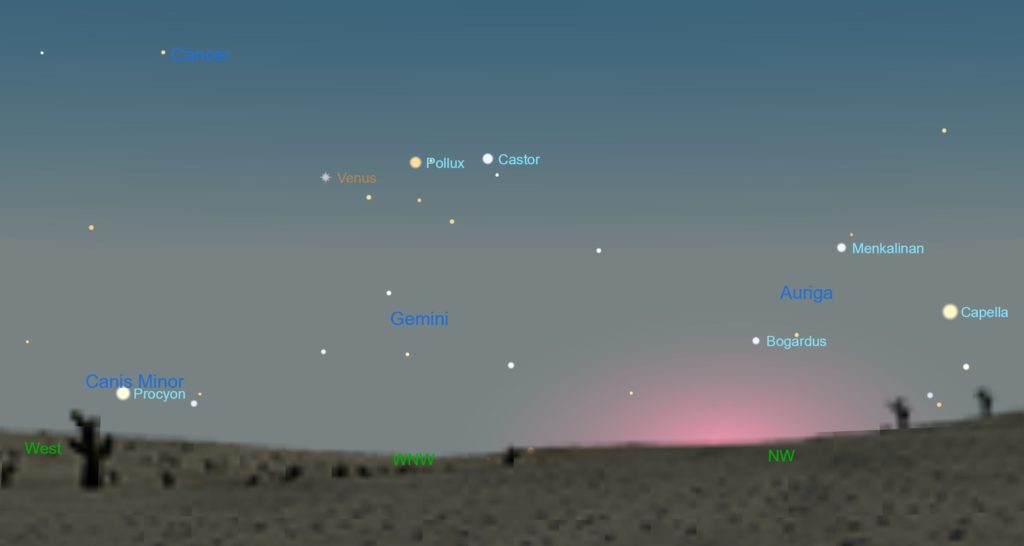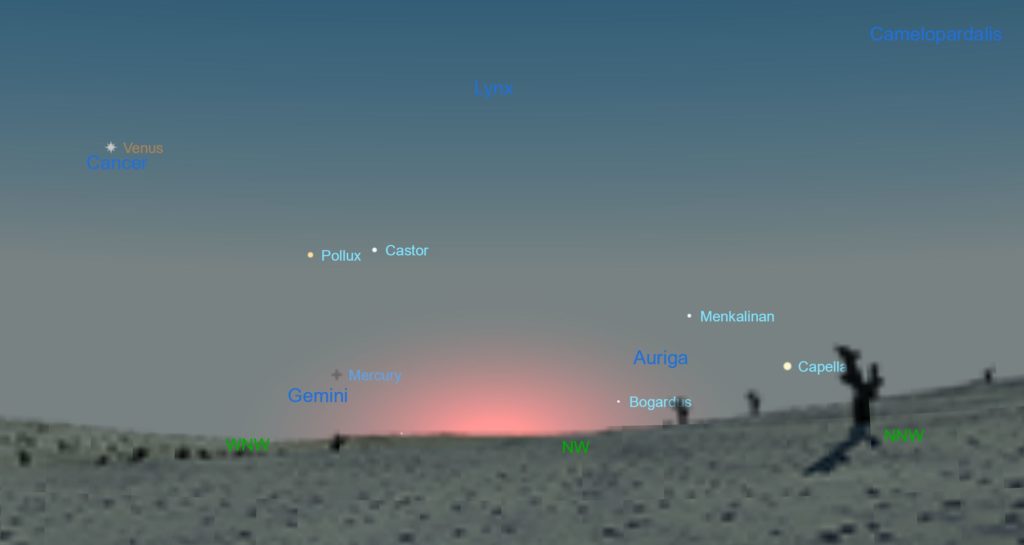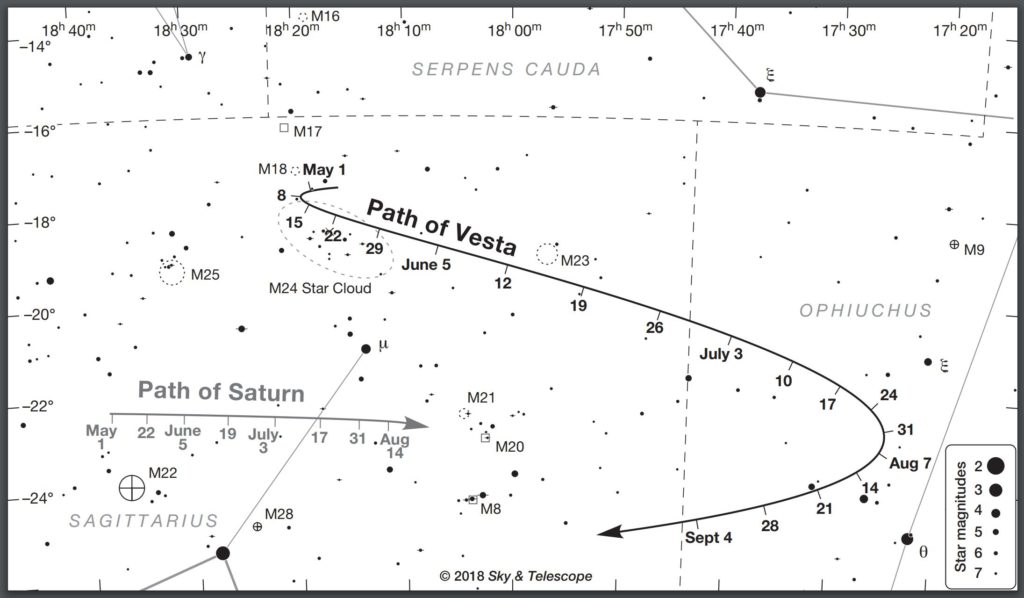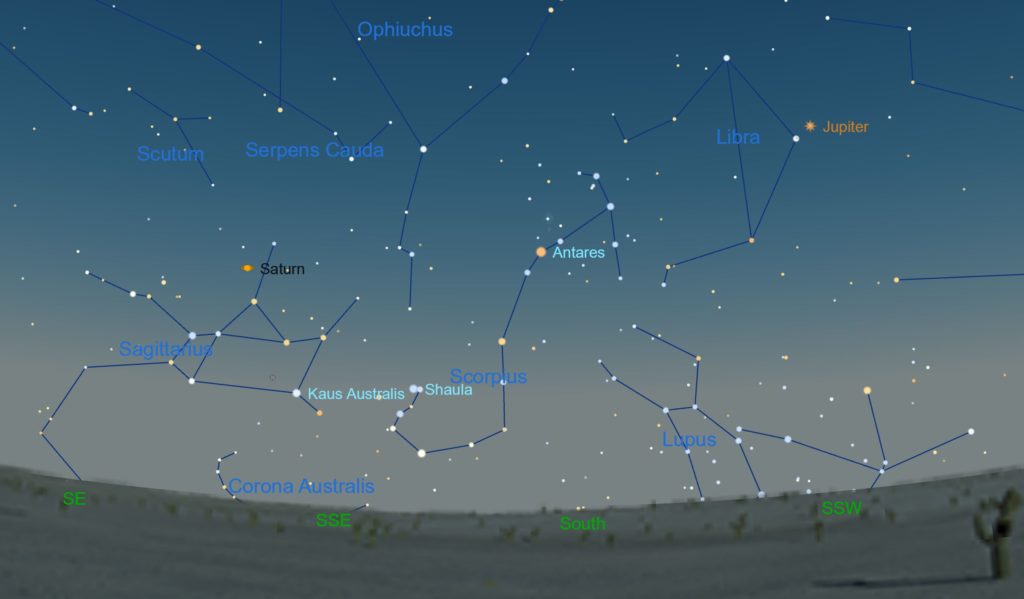The Night Sky This Month – June 2018

The best stargazing of the year begins now. Through June and into July, the planets Jupiter, Saturn, and Mars make their best apparitions in many years and reveal plenty of fascinating detail in a small telescope. Venus and Mercury also make appearances, as does the big asteroid Vesta which grows bright enough to see without optics. And of course, the best part of the Milky Way returns with its rich collection of hundreds of star clusters, star-forming regions, dark nebulae, and star clouds. Here’s what to see in the night sky this month…
1 June. Look for Saturn about 1.5º south of the waning gibbous Moon well after midnight. The pair are just above the Teapot of Sagittarius in the southeastern sky.
3 June. The Moon is 3º north of the brightening planet Mars in southeastern pre-dawn sky.
6 June. Mercury lost in the Sun’s glare at superior conjunction on the far side of the Sun as seen from Earth. It will return to the evening sky later this month.
6 June. Last Quarter Moon, 18:32 UT
10 June. Venus is joined by the two brightest stars of Gemini, Castor and Pollux, in the western sky after sunset. The planet is about 28 degrees above the horizon in early June for northern observers, and slightly higher for southern observers. It brightens a little to magnitude -4.1 over the month and slowly begins to grow larger (about 15”) and less illuminated (from 80% to 70%).

13 June. New Moon, 19:43 UT
15 June. Mercury emerges in the evening sky for the rest of June and into July. Look for the planet getting higher in the western sky after sunset. By month’s end, it sets more than an hour after the Sun and shines at an impressive magnitude 0.1. A pair of binoculars will help you pick it out of the twilight glare. The planet is about 6” across and, in a telescope, reveals a gibbous disk about 60% illuminated.

16 June. Spectacular Venus is just 2º north of the slender crescent Moon (about two finger widths held at arm’s length). The Moon is also about 1.5º south of M44, the Beehive star cluster. They all make for fine viewing through a pair of binoculars in the western sky after the Sun goes down. I challenge you to find a prettier sight anywhere.
19 June. The asteroid Vesta reaches opposition. After the dwarf planet Ceres, Vesta is the second-most massive body in the solar system asteroid belt. Its mean diameter is a respectable 525 km. But, unlike Ceres, it does not have sufficient gravity to pull itself into a spherical shape, which is why it didn’t make the grade as a dwarf planet. Vesta lies in northern Sagittarius, not far from Saturn, and reaches a peak brightness of magnitude 5.3. That’s bright enough to see without optical aid in dark sky. The chart below, courtesy of Sky and Telescope magazine, shows you where to find it from day to day.

20 June. Grab your binoculars and have a look at Venus just 0.4º north of the Beehive cluster in the western sky after sunset.
20 June. First Quarter Moon, 10:51 UT
21 June. At 10:07 UT, the Sun reaches northern solstice, the northernmost point on the ecliptic, where it appears to stand still for a day before slowly moving southward again. This marks the first day of summer in the northern hemisphere and the first day of winter south of the equator. At solstice, the Sun lies near the star Propus at the foot of Gemini, not far from the star cluster M35.
23 June. Jupiter lies just 4º south of the waxing gibbous Moon. Just a month past opposition, the big planet remains a resplendent sight in June. It slowly dims and grows smaller this month, but at magnitude -2.4, it’s still brighter by far than any star. The planet’s disk spans about 45”and continues to reveal plenty of detail in a telescope. Learn more about what to see on and around Jupiter in the Cosmic Pursuits Jupiter observing guide.
27 June. The planet Saturn reaches opposition, rising in the eastern sky as the Sun sets in the west. This marks the closest approach of Earth to the ringed planet in 2018. The planet reaches magnitude 0.0 and its disk spans about 18”. The rings are more than twice as wide as the disk. This year, the rings are tilted splendidly towards our line of sight by some 24º. It’s a great time to see this planet, which many new and experienced skywatchers rank as the most beautiful thing you can see through a telescope. Because the planet is in the southern reaches of the ecliptic, this year’s apparition favors southern stargazers. But northerners can see plenty on nights of good seeing.

28 June. Mars stops its eastward motion and becomes stationary relative to the background stars. For the next many weeks, and through its opposition on July 27, the planet will appear to move westward from day to day. This is called retrograde motion. At the end of June, Mars lies well to the east of Saturn in the constellation Capricorn. The planet gets down to business this month, brightening from magnitude -1.2 to -2.2 and growing to 20” across. On nights of steady seeing, it will reveal plenty of detail in a good telescope at moderate to high magnification. The planet rises around midnight as June begins and 10:30 p.m. as the month ends.
28 June. Full Moon, 04:53 UT